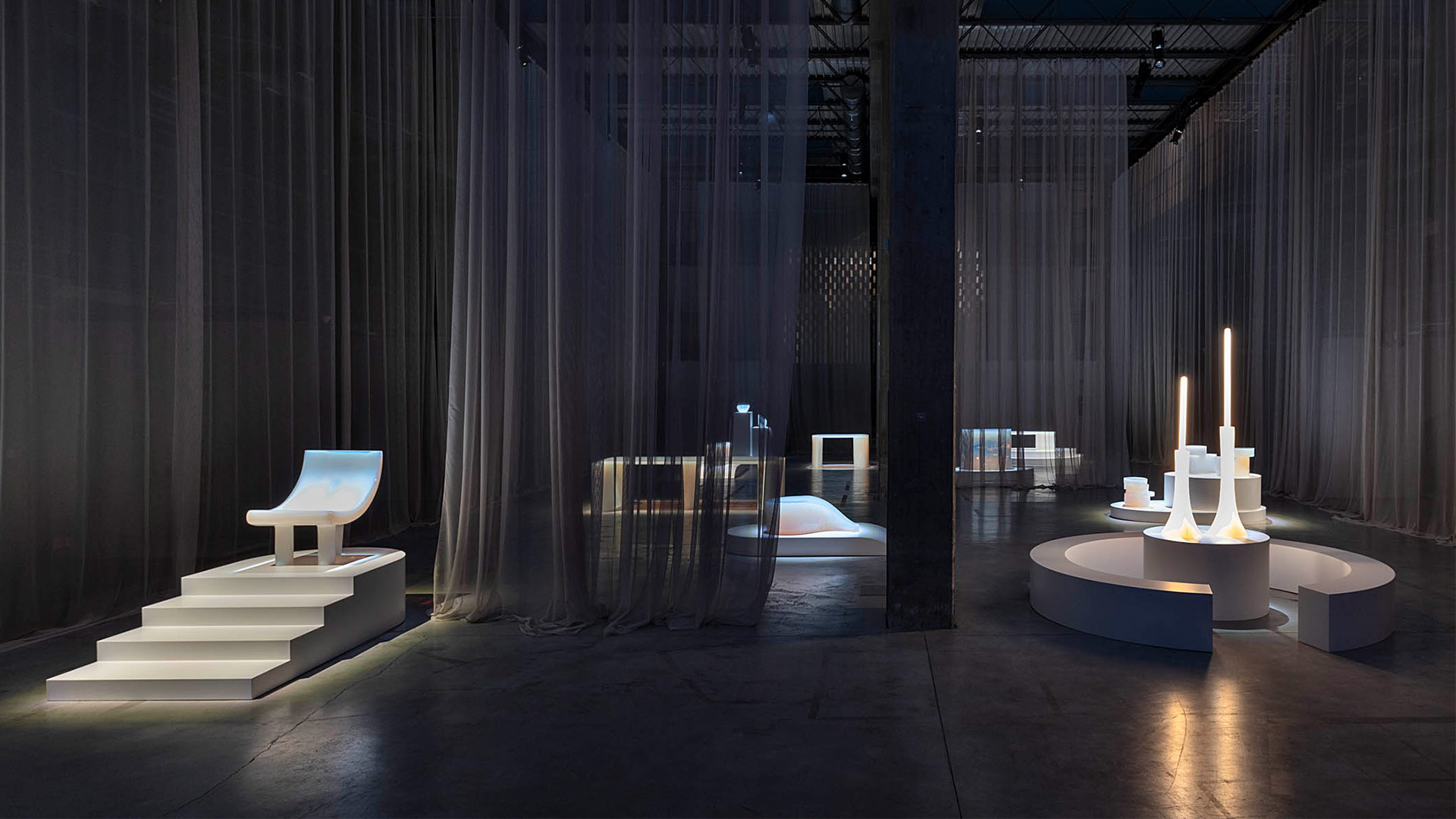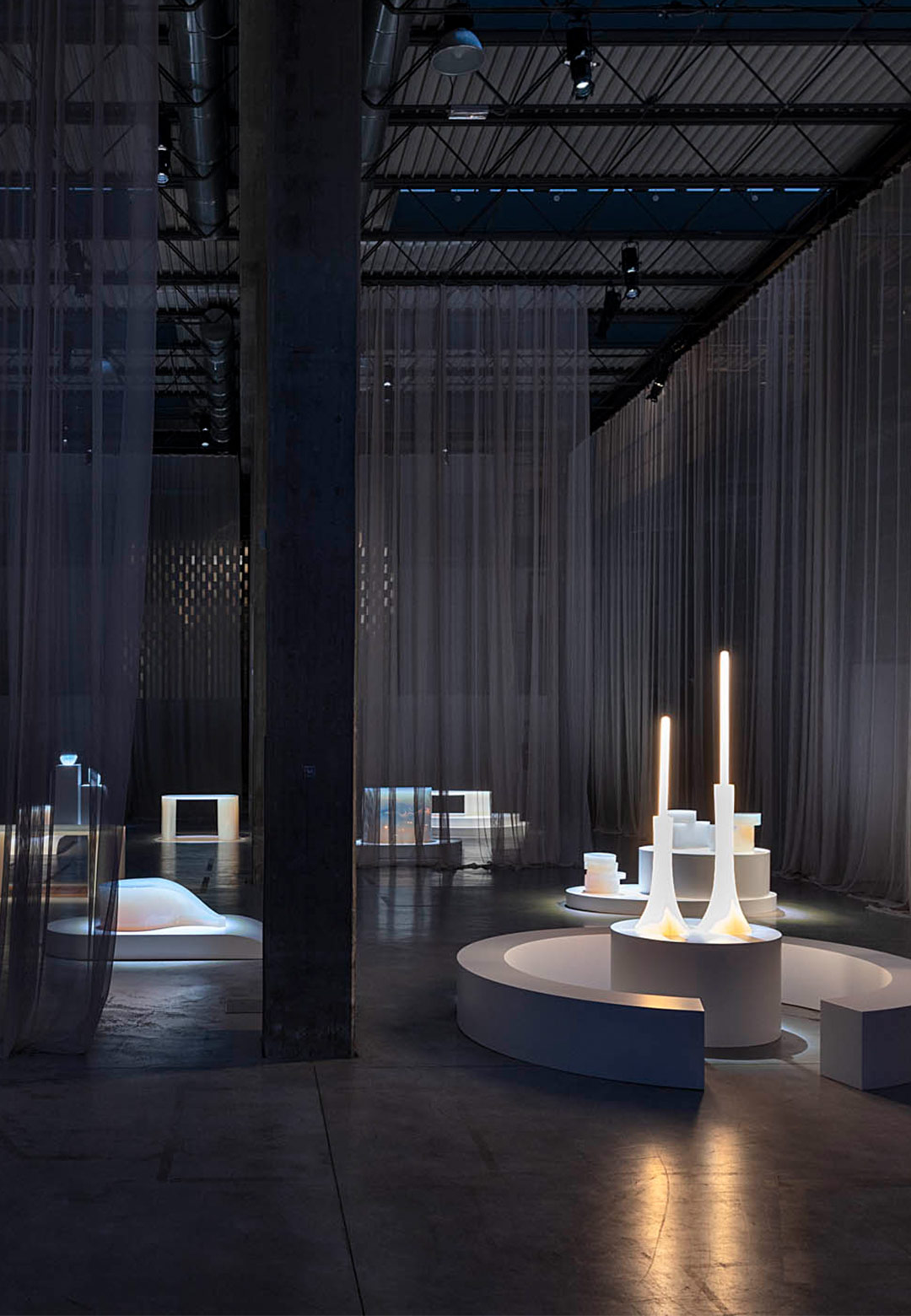Iridescence is an elusive visual phenomenon of a surface that appears to change colour gradually as it moves or as the angle of view or light changes. A rainbow of colours is created when light interferes in waves within microstructures of thin films. It exists at a moment and is ever-changing. The Ancient Greeks called it ‘Poikilos’, which can be translated as ‘of many colours’. Ancient people witnessed it in the feathers of a bird, the movement of a snake or leopard, on seashell nacre and minerals such as opal.
Greek designer, Eleni Petaloti and Leonidas Trampoukis, who together form Objects of Common Interest, unveiled their new show, Poikilos, at Nilufar Gallery during Milan Design Week 2023. Exploring new forms of iridescence, the hand-shaped resin designs appear white, pearly and ethereal thanks to the playful affair between the light in the atrium and the secret resin production recipe Objects of Common Interest has perfected.
Sharing her thoughts on iridescence, Valentina Ciuffi, curator of the exhibition and founder of Studio Vedèt says, "It has the charm of dazzling and unexpected things, that vibrate and cannot stand still. It is no coincidence that the earliest references to the concept of iridescence—which date back to ancient Greece—refer to the coat or skin of living creatures. Poikilos was, in fact, the word used at the time to describe the mottled fur of a running leopard or the iridescent skin of a snake. Iridescence seems to originate from a movement or movements and remain alive in them."
Working between their two studios in New York and Athens, Objects of Common Interest has an intriguing story behind their production. Years ago, Eleni Petaloti met Ovidiu Colea, a Romanian man who moved to America early in his life. He was the master of a workshop in Long Island, dedicated to producing and experimenting with resin. During his years of experimentation, Ovidiu developed innovative and secret recipes that were never used before. Curator Valentina Ciuffi explains, “The story of this encounter between ‘designer’ and ‘craftsman’ goes far beyond what we are used to observing: indeed, Ovidiu in 2019 was ready to retire and did not know to whom to leave all his wealth of knowledge and unknown and miraculous machinery and recipes. When Eleni and Leo bravely accepted the baton and decided to transport it to a large space in the Piraeus industrial zone of Athens, all the knowledge of this man was reactivated in their own Hellenic factory.”
The designs unveiled in Poikilos came to life thanks to this secret recipe that Ovidiu handed down to Objects of Common Interest. As Ciuffi describes, “this potion of opalescence” is cast in moulds and then manually treated to find its final form. This approach differs from the conventional methods of shaping resin, such as CNC machines. This connection between the innovative and traditional production methods is a signature of the design duo and is visible in their previous projects.
Zeynep Rekkali Jensen: Your projects relate to ancient as well as futuristic aesthetics, techniques, and production technology. Where does your aesthetic come from?
Objects of Common Interest: We are intrigued by many different elements from different fields: nature, minimal art, found elements in the urban environment, history and our own personal memories and experiences in an abstract way. We tend not to replicate ideas and create variations of a similar work language, rather each time start from scratch and think of a project around its context and our current state of mind and research directions. We blend and alternate techniques of making and producing, from the machined to the handmade and back and forth. We often design digitally and transfer ideas directly into the final piece, other times take our time through research, studies, mock-ups and tryouts. The aesthetics in that sense is very personal, intuitive, and changing, but there are underlying concepts and ideas that we stem from that are the basis of our thought process.
Zeynep: Your previous project Future Archaeology explored iridescent finishes on steel. What is your approach to the material, and how does it pertain to the final forms you create?
Objects of Common Interest: Often is the material driving the creative decisions- starting off with an obsession with material and exploring how to use its properties to their core principles – steel for its weight, sturdiness, bendability and finish properties, wood for its tactility or its sculptural workability and so on... Other times it is an abstract concept, an idea that naturally directs what material or combination of materials to be used, staying loyal to the clarity of the concept following it all the way to the articulation, materiality, colour, transparency etc. I.e., for creating the illusion of weight, a seemingly large and heavy object but being rendered weightless, as in the case of Standing Stones, inflatable sculptural elements that may sway with a light wind and are soft in touch, but from afar stand solid and as made of glass, as presented at our solo show at Brussel Design Museum and later at our Noguchi Museum exhibition.
Zeynep: This show at Nilufar Depot has a rich human story behind it, considering how you inherited this production facility from your friend. How did your friendship unfold, and how did you make the decision to revive his techniques in Athens?
Objects of Common Interest: It is our first project where we handle the production of our own pieces of a show in its totality. This exhibition is a mono-material presentation of domestic objects – chairs, side tables, consoles, dining tables, lamps etc made of an iridescent resin material that we have developed uniquely at our - just launched - resin fabrication facility that we set up at the port of Piraeus area in Athens, an area with rich manufacturing history and of amazing creative energy. We are continuing and expanding in our own creative way the fabrication studio of Ovidiu Colea, who pioneered resin production in New York City for 40 years. The show at Nilufar, entitled Poikilos, is the first-time resin is handled in a totally handmade process, sculpting objects by hand, moulding, and casting in gently organic forms that reveal the process in their surface and tactility. This has been an intentional aspect we wanted to bring in this material that is known for its machined perfect-cut surfaces.
Zeynep: This production facility was where you created some of your most iconic designs, for example, the Opal Bent Stool. Now that you have it under your hand in Athens, I am guessing the sky is the limit. What does the future hold?
Objects of Common Interest: We work with mould making and casting in all possible sorts of forms and material specifications and this allows us the freedom to experiment with larger-scale and complex geometry objects. We have just started to explore the potential of these techniques and we plan to challenge ourselves. We will still continue working as mentioned earlier, each project stemming not only from a material initiative but the concept showing the way for the materiality, so resin has now been added to our material vocabulary, alongside many materials that we have been working with in the past, such as marble, wood, steel, inflatables etc.
Zeynep: Finally, I want to ask you about the fountain you created for this year's Alcova exhibition. It is probably one of your most conceptual installations yet. How did it come to life?
Objects of Common Interest: It is described above that the context gave birth to an idea, that we would otherwise not have come up with. We were called to improvise with an open brief for a site, the public grounds of this year’s Alcova’s home. We have had a love-hate relationship with public fountains, at the same time being landmarks and awkward decorative space fill-ins, public activation nodes or neglected dirt-filled vessels. “Echoes”, as we have named this installation is almost an anecdote, a comment to this historic typology of structure, where we jet the water through a transparent bow-up object floating atop an artificial water basin, a totally portable element that can be packed, transported and reinstalled literally anywhere, outdoors, indoors, on a rooftop, rendering this known as magnificent, heroic, often commissioned for permanence feature, a collectible item.
ABOUT Objects of Common InterestWorking within the realm of art, design and architecture, the duo work across various scales; from objects and installations to interactive immersive environments and interior spaces. They are also founding partners of the sibling studio LOT office for architecture. Their work has been exhibited at art and design institutions, galleries, and fairs – including solo shows at the Noguchi Museum, Etage Projects, Carwan Gallery, Architecture Biennale, and the Salone del Mobile in Milan. Their work involves various collaborations; such as the partnership with Kvadrat to produce the object/installation Doric Column – Kinetic Object, the design of the new store of Nili Lotan in Palm Beach, and public installations such as the project Lights On, which was commissioned by Cultural Capital of Italy 2023. Objects of Common Interest was formed with the focus on creating still-life installations and experiential environments and objects, demonstrating a fixation with materiality, concept, and tangible spatial experiences. The work roots in an amalgamation of thinking and making between two diverse poles, Greece, and New York.
STIR’s coverage of Milan Design Week 2023 showcases the best exhibitions, studios, designers, installations, brands, and special projects to look out for. Explore Euroluce 2023 and all the design districts—5Vie Art and Design, Brera Design District, Fuorisalone, Isola Design District, Tortona District, and Milano Design District—with us.






 Sign in with email
Sign in with email










What do you think?